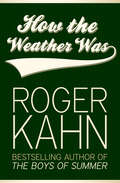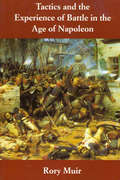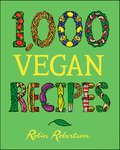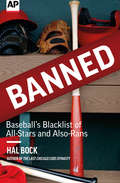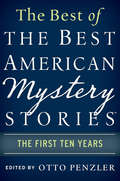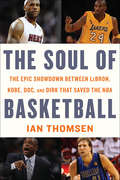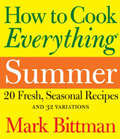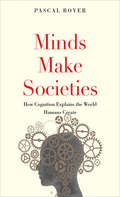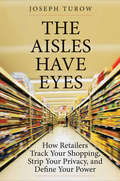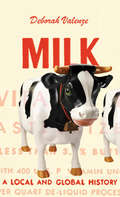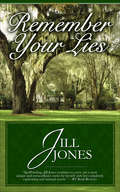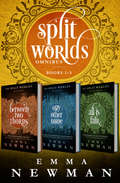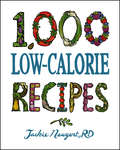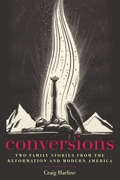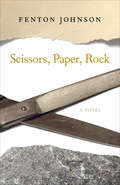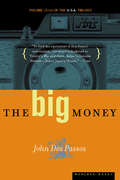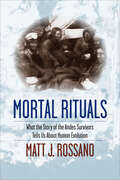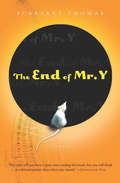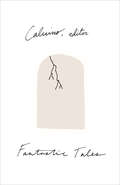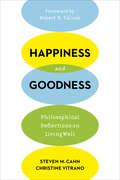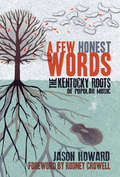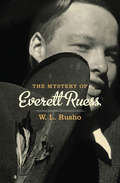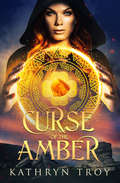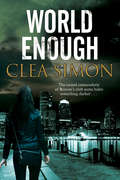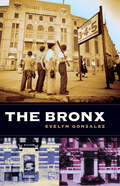- Table View
- List View
How the Weather Was
by Roger KahnThe author of The Boys of Summer writes about an array of legendary figures in this collection of essays and interviews from the late 1950s to the 1970s. &“… In the end, the range, like the style, reflects myself. Let the present, then, and the recent past, the ball players, poets, policemen, professors, musicians—in short, these emperors and clowns—stride before you, each hoping, as the author does, to please.&” Robert Frost, Claudio Arrau, John Lardner, Jackie Robinson, Babe Ruth, Willie Mays, Leo Durocher, Bobby Thomson, Al Rosen, Jascha Heifetz, and other celebrities in their years of glory, in their times of trial. This is a book about people to be remembered, and what it was like in America at a very special time.&“Beautiful…persons and events through the eyes of a sharp, articulate observer.&”—New York Times &“No one else has written a piece so startling about the legend of Babe Ruth…After reading this book you will never feel the same about a lot of legends…A very special book…A book to treasure.&”—Chicago Sun-Times &“Irresistible…You can&’t stop reading!&”—Chicago Tribune
Tactics and the Experience of Battle in the Age of Napoleon
by Rory MuirThis historical study of Napoleonic battles and tactics examines firsthand accounts from soldiers&’ memoirs, diaries, and letters: &“A major work&” (David Seymour, Military Illustrated). In this illuminating volume, historian Rory Muir explores what actually happened in battle during the Napoleonic Wars, putting special focus on how the participants&’ feelings and reactions influenced the outcome. Looking at the immediate dynamics of combat, Muir sheds new light on how Napoleon&’s tactics worked. This analysis is enhanced with vivid accounts of those who were there—the frightened foot soldier, the general in command, the young cavalry officer whose boils made it impossible to ride, and the smartly dressed aide-de-camp, tripped up by his voluminous pantaloons. Muir considers the interaction of artillery, infantry, and cavalry; the role of the general, subordinate commanders, staff officers, and aides; morale, esprit de corps, soldiers&’ attitudes toward death and feelings about the enemy; the plight of the wounded; the difficulty of surrendering; and the way victories were finally decided. He discusses the mechanics of musketry, artillery, and cavalry charges and shows how they influenced the morale, discipline, and resolution of the opposing armies. "Muir has filled an important gap in the study of the Napoleonic era."—Library Journal
1,000 Vegan Recipes (1,000 Recipes #6)
by Robin RobertsonA treasury of meat-free, dairy-free delights from &“an acclaimed authority on vegan cooking&” (Publishers Weekly). These delicious recipes, for breakfast, lunch, dinner and everything in between, are cholesterol-free, low in saturated fat, and high in fiber and complex carbohydrates. You'll get crowd-pleasing appetizers and snacks like Mango-Avocado Spring Rolls and Savory Artichoke Squares and family favorites like Vegan Margarita Pizza and Baked Mac and Cheeze. Best of all, Robin Robertson gives you an endless variety of recipes from a diverse range of cultures—with something to suit everyone&’s taste. For anyone interested in healthy, delicious eating that&’s also ethically and environmentally responsible, 1,000 Vegan Recipes: Includes a &“FAST&” icon featuring quick and easy recipes that can be ready in 30 minutes or lessProvides kid-friendly recipes to help you get your kids to eat more nutritious foodsOffers detailed information and guidelines on ingredient substitutions, special nutritional concerns, and a handy list of important pantry staples Presents vegan alternatives to restaurant favorites with recipes such as Penne with Vodka-Spiked Tomato Sauce, Fajitas Without Borders, Cheezecake with Cranberry Drizzle, Vegan Tiramisu, and vegan ice creams, sorbets, and granitas
Banned: Baseball's Blacklist of All-Stars and Also-Rans
by Hal Bock The Associated PressAward-winning Associated Press sports writer Hal Bock brings us a fascinating history of the players, coaches and more barred from baseball's ranks, from Shoeless Joe Jackson to Jenrry Mejia. "Banned: Baseball's Blacklist of All-Stars and Also-Rans" weaves together tales of lesser-known characters from baseball's early years with infamous outlaws who have endured throughout the decades. Featuring stories of players like Eddie "The Only" Nolan, Cozy Dolan, Leo Durocher, and Pete Rose who have been expelled or suspended from the sport, Bock's chronicle delves deep into baseball's colorful history. For those who follow the current corporate era of businessmen players and billionaire owners, this book serves as a reminder that America's Pastime evolved from the days when gamblers filled the stands and influenced poorly paid scoundrels on the diamond.In his over 40-year career, Hal Bock has covered every major event on the sports calendar, including 30 World Series, 30 Super Bowls and 11 Olympic Games, making him the perfect storyteller for this retrospective. Featuring an introduction by John Thorn, the Official Historian of Major League Baseball, and more than 25 photographs from the Associated Press archives, "Banned" is a must-read for any fan of the game.
The Best of the Best American Mystery Stories: The First Ten Years (The Best American Series)
by Otto PenzlerTwenty great whodunnits from the first decade of this series, edited by the award-winning editor and founder of the Mysterious Press. This anthology collects the top twenty stories from the first decade (1997–2006) of The Best American Mystery Stories, selected and introduced by Otto Penzler. Contributors include Russell Banks, Jeffrey Deaver, Louise Erdrich, Brendan DuBois, Dennis Lehane, Elmore Leonard, Lou Manfredo, Ed McBain, Joyce Carol Oates, Scott Turow, and many others.
The Soul of Basketball: The Epic Showdown Between LeBron, Kobe, Doc, and Dirk That Saved the NBA
by Ian Thomsen&“A fascinating, thorough look at pro basketball&’s continuing evolution to becoming the &‘sport of the American Dream.&’&”—Publishers Weekly The Soul of Basketball tells the story of an NBA prodigy, his league, and their sport in the throes of crisis during the pivotal 2010-11 season. It began with The Decision, that infamous televised moment when uber-star LeBron James revealed that he was leaving the Cleveland Cavaliers—thereby distancing himself from his role model Michael Jordan—to pursue his first championship with his former opponents on the Miami Heat. To the great fortune of LeBron, the NBA, and basketball itself, the mission didn&’t work out as planned. In this book, veteran NBA writer Ian Thomsen portrays the NBA as a self-correcting society in which young LeBron is forced to absorb hard truths inflicted by his rivals Kobe Bryant, Doc Rivers, and Dirk Nowitzki, in addition to lessons set forth by Pat Riley, Gregg Popovich, Larry Bird, David Stern, Joey Crawford, and many more. Brimming with inside access, The Soul of Basketball tells the inspiring story of LeBron&’s loneliest year, insecure and uncertain, when his ultimate foe was an unlikely immigrant who renewed the American game&’s ideals. From Miami to Boston, Los Angeles to Dallas, Germany to the NBA&’s Manhattan headquarters, the biggest names in basketball are driven by something more valuable than money and fame—a quest that would pave the way for Stephen Curry, Kevin Durant, and future generations to thrive. &“Ian Thomsen provides an antidote to the fast-food, twitter feed of instant information consumption…deft prose and snappy anecdotes…Great, great stuff.&”—Leigh Montville, New York Times-bestselling author of Sting Like a Bee &“A fine work of sports journalism.&”—Kirkus Reviews (starred review)
How to Cook Everything: 20 Fresh, Seasonal Recipes and 32 Variations
by Mark BittmanSummer cooking, simplified—with a recipe collection from the #1 New York Times-bestselling author.Summer cooking is a breeze with this inspiring collection of easy recipes from Mark Bittman, author of the award-winning How to Cook Everything. This quick reference is the perfect companion for a weekend getaway, a stroll through the farmers' market, a casual outdoor party, and planning simple everyday meals. How to Cook Everything Summer includes 20 of Bittman's favorite seasonal recipes—plus 32 variations—designed to help you eat well on even the laziest days, all with hints for ways to improvise with new foods and flavors. From garden-fresh salads, chilled soups, and picnic-portable sandwiches to mouthwatering ideas for the grill, quickly prepared fish and shellfish, and luscious fruit desserts, you'll find all you need to enjoy the most delicious summer ever.
Minds Make Societies: How Cognition Explains the World Humans Create
by Pascal BoyerA scientist integrates evolutionary biology, genetics, psychology, economics, and more to explore the development and workings of human societies. &“There is no good reason why human societies should not be described and explained with the same precision and success as the rest of nature.&” Thus argues evolutionary psychologist Pascal Boyer in this uniquely innovative book. Integrating recent insights from evolutionary biology, genetics, psychology, economics, and other fields, Boyer offers precise models of why humans engage in social behaviors such as forming families, tribes, and nations, or creating gender roles. In fascinating, thought-provoking passages, he explores questions such as: Why is there conflict between groups? Why do people believe low-value information such as rumors? Why are there religions? What is social justice? What explains morality? Boyer provides a new picture of cultural transmission that draws on the pragmatics of human communication, the constructive nature of memory in human brains, and human motivation for group formation and cooperation.&“Cool and captivating…It will change forever your understanding of society and culture.&”—Dan Sperber, co-author of The Enigma of Reason&“It is highly recommended…to researchers firmly settled within one of the many single disciplines in question. Not only will they encounter a wealth of information from the humanities, the social sciences and the natural sciences, but the book will also serve as an invitation to look beyond the horizons of their own fields.&”—Eveline Seghers, Evolutionary Studies in Imaginative Culture
The Aisles Have Eyes: How Retailers Track Your Shopping, Strip Your Privacy, and Define Your Power
by Joseph TurowThe author of Media Today offers &“a trenchant, timely, and troubling account of [retailers&’] data-mining, in-store tracking, and predictive analytics&” (The Philadelphia Inquirer). By one expert&’s prediction, within twenty years half of Americans will have body implants that tell retailers how they feel about specific products as they browse their local stores. The notion may be outlandish, but it reflects executives&’ drive to understand shoppers in the aisles with the same obsessive detail that they track us online. In fact, a hidden surveillance revolution is already taking place inside brick-and-mortar stores, where Americans still do most of their buying. Drawing on his interviews with retail executives, analysis of trade publications, and experiences at insider industry meetings, advertising and digital studies expert Joseph Turow pulls back the curtain on these trends, showing how a new hyper-competitive generation of merchants—including Macy&’s, Target, and Walmart—is already using data mining, in-store tracking, and predictive analytics to change the way we buy, undermine our privacy, and define our reputations. Eye-opening and timely, Turow&’s book is essential reading to understand the future of shopping. &“Turow shows shopping today to be an exercise in unwitting self-revelation—and not only online.&”—The Wall Street Journal &“Thoroughly researched and clearly presented with detailed evidence and fascinating peeks inside the retail industry. Much of this information is startling and even chilling, particularly when Turow shows how retail data-tracking can enable discrimination and societal stratification.&”—Publishers Weekly &“Revealing . . . Valuable reading for shoppers and retailers alike.&”—Kirkus Reviews
Milk: A Local and Global History
by Deborah ValenzeThe illuminating history of milk, from ancient myth to modern grocery store.How did an animal product that spoils easily, carries disease, and causes digestive trouble for many of its consumers become a near-universal symbol of modern nutrition? In the first cultural history of milk, historian Deborah Valenze traces the rituals and beliefs that have governed milk production and consumption since its use in the earliest societies.Covering the long span of human history, Milk reveals how developments in technology, public health, and nutritional science made this once-rare elixir a modern-day staple. The book looks at the religious meanings of milk, along with its association with pastoral life, which made it an object of mystery and suspicion during medieval times and the Renaissance. As early modern societies refined agricultural techniques, cow's milk became crucial to improving diets and economies, launching milk production and consumption into a more modern phase. Yet as business and science transformed the product in the nineteenth and twentieth centuries, commercial milk became not only a common and widely available commodity but also a source of uncertainty when used in place of human breast milk for infant feeding. Valenze also examines the dairy culture of the developing world, looking at the example of India, currently the world's largest milk producer.Ultimately, milk&’s surprising history teaches us how to think about our relationship to food in the present, as well as in the past. It reveals that although milk is a product of nature, it has always been an artifact of culture.
Remember Your Lies
by Jill JonesAn ex-cop is drawn into a twisted game of violence and voodoo when she&’s arrested for a murder she didn&’t commit in this Southern romantic thriller. Ex-cop Angela Donahue has traded a life of mystery and danger for one of tranquility when she ended her career with the Georgia Bureau of Investigation. But when she&’s arrested for the murder of a man she&’s never even heard of, she realizes that her old life isn&’t as far behind her as she&’d hoped. And neither is the man who once betrayed her heart… Upon receiving news of her arrest, undercover operative Dylan Montana returns from Angela&’s past, determined to clear the name of the woman he still loves. With staggering evidence against her and threats growing more deadly, Angela has no choice but to trust a man she swore she&’d never trust again. But in a whirlwind of deceit, violence, and murder, if Dylan wants to reclaim her heart, he&’ll have to save her life first.&“Voodoo, danger and romance all combine to construct an on the edge of your seat thriller!&”—RT Reviews
A Split Worlds Omnibus: Between Two Thorns, Any Other Name, and All Is Fair (The Split Worlds)
by Emma NewmanNow in one volume: the first three novels in the urban fantasy series &“that playfully mixes magic and interesting characters into an intriguing mystery&” (Kirkus Reviews). Between Mundanus, the world of humans, and Exilium, the world of the Fae, lies the Nether, a mirror-world where the social structure of 19th-century England is preserved by Fae-touched families who remain loyal to their ageless masters. Born into this world is Catherine Rhoeas-Papaver, who escapes it all to live a normal life in Mundanus, free from her parents and the strictures of Fae-touched society. But now she&’s being dragged back to face an arranged marriage, along with all the high society trappings it entails. Crossing paths with Cathy is Max, an Arbiter of the Split Worlds treaty with a dislocated soul who polices the boundaries between the worlds, keeping innocents safe from the Fae. After a spree of kidnappings and the murder of his fellow Arbiters, Max is forced to enlist Cathy&’s help in unravelling a high-profile disappearance within the Nether. Getting involved in the machinations of the Fae, however, may prove fatal to all involved. The Split Worlds Omnibus—spanning Between Two Thorns, Any Other Name, and All Is Fair—presents the intricately plotted and delightfully suspenseful world Emma Newman has crafted.Praise for the Split Worlds series&“JK Rowling meets Georgette Heyer . . . Newman renders the Split Worlds with verve and an infectious sense of fun, and presents in Cathy a strong and personable heroine.&”—The Guardian &“Learning to be a young lady has never seemed so dangerous.&”—Mary Robinette Kowal, Hugo and Nebula Award-winning author of the Lady Astronaut series
1,000 Low-Calorie Recipes (1,000 Recipes #21)
by Jackie Newgent&“This is a gem of a cookbook. Not only is it loaded with healthy recipes, everything I&’ve made from pizza to salad dressing has been a showstopper.&”—Tara Collingwood, &“The Diet Diva,&” Healthline This incredible cookbook is packed with tasty, low-calorie recipes that give home cooks an unparalleled variety of meals and ideas for eating healthfully that their whole family will love. Every recipe clocks in at less than 500 calories, but most are no more than 300 calories per serving. They&’re easy to make and take the guesswork out of portion control and calorie counting. Recipes include complete nutrition information, and full menus help home cooks maintain a balanced eating approach—naturally. 1,000 Low-Calorie Recipes covers finger foods and snacks; salads and soups; meat, poultry, fish, and vegetarian entrees; breads and muffins; and yes, even desserts and cocktails. You&’ll find rustic comfort foods like Five-Spice Turkey Chili, favorites like Pizza Margherita, main courses like Tart Apple-Stuffed Pork Loin, plus innovative recipes that will intrigue and satisfy you, like Caprese Salad Lasagna, Five-Spice Yam Frites, Brooklyn Lager Baked Beans, Homemade Pretzel Puffs, Fudgy Superfood Brownies, and Chocolate Mint Almond-tinis. Written by Jackie Newgent, a well-respected Registered Dietitian who writes for and is interviewed by national media, such as The Dr. Oz Show, Cooking Light, Health, and Redbook, among others Includes clever advice on stocking a low-calorie pantry, maintaining a healthy weight, diet-friendly cooking, nutritious ingredient substitutions, full menus, and more Features ingredients that are fresh and flavorful, keeping with Jackie Newgent&’s &“real foods&” philosophy: nothing is artificial Whether you&’re following a particular diet or just want a single go-to guide for nutritious family meals, 1,000 Low-Calorie Recipes is the ultimate resource.
Conversions: Two Family Stories from the Reformation and Modern America (New Directions in Narrative History)
by Craig HarlineThe experiences of two families—one in seventeenth-century Holland, the other in America today—and how they coped when a family member changed religions.This powerful and innovative work by a gifted cultural historian explores the effects of religious conversion on family relationships, showing how the challenges of the Reformation can offer insight to families facing similarly divisive situations today.Craig Harline begins with the story of young Jacob Rolandus, the son of a Dutch Reformed preacher, who converted to Catholicism in 1654 and ran away from home, causing his family to disown him. In the companion story, Michael Sunbloom, a young American, leaves his family&’s religion in 1973 to convert to Mormonism, similarly upsetting his distraught parents. The modern twist to Michael&’s story is his realization that he is gay, causing him to leave his new church, and upsetting his parents again—but this time the family reconciles.Recounting these stories in short, alternating chapters, Harline underscores the parallel aspects of the two far-flung families. Despite different outcomes and forms, their situations involve nearly identical dynamics and heart-wrenching choices. Through the author's deeply informed imagination, the experiences of a seventeenth-century European family are transformed into immediately recognizable terms.&“A beautiful and moving book. Harline is a master at narrative and at making the most painstaking research look effortless.&” —Carlos Eire, Yale University&“An absorbing, creative book . . . it will definitely become a go-to book for readers interested in the history and psychology of conversion.&” —Lauren Winner, author of Girl Meets God: A Memoir&“An unexpected joy. . . . A compelling, insightful examination. . . . Conversions is a journey well worth taking.&” —Gerald S. Argetsinger, Affirmation.org
Scissors, Paper, Rock: A Novel (Kentucky Voices)
by Fenton JohnsonTwo generations of a Kentucky family struggle with loss and reunion in a novel by a Lambda Award winner: &“Brilliant . . . emotional jolts lurk on every page.&” —Entertainment Weekly Despite the emotional distance that has long existed between them, Raphael Hardin has left San Francisco to care for his dying father in his rural Kentucky hometown. Raphael had finally made a life for himself in California, away from the tiny Appalachian town of Strang Knob—but now that life is threatened by an AIDS diagnosis. As father and son reunite, the story moves to Raphael&’s siblings, among them an alcoholic brother haunted by guilt and a sister beset by loneliness—as well as Miss Perkins, an unmarried schoolteacher who has known the Hardins for decades—painting a portrait of a family and a community, of blood struggles, broken hearts, and binding loves. &“Powerfully moving.&” —New York Times Book Review &“A seductive rumination on the ways that memory can torment or soothe, and sometimes do both at the same time.&” —San Francisco Chronicle &“A wise and compassionate novel.&” —Publishers Weekly
The Big Money: Volume Three Of The U. S. A. Trilogy (U.S.A. Trilogy #3)
by John Dos Passos&“It is not simply that [Dos Passos] has a keen eye for people, but that he has a keen eye for so many different kinds of people.&”—The New York TimesMarking the end of &“one of the most ambitious projects that an American novelist has ever undertaken&” (Time), The Big Money brings us back to America after the Great War, a nation on the upswing. Industrialism booms. The stock market surges. Lindbergh takes his solo flight. Henry Ford makes automobiles. From New York to Hollywood, love affairs to business deals, it is a country taking the turns too fast, speeding toward the crash of 1929. Ultimately, whether the novels of John Dos Passos&’s classic USA Trilogy are read together or separately, they paint a sweeping portrait of collective America—and showcase the brilliance and bravery of one of its most enduring and admired writers. The Big Money, focusing on a passionate pilot whose compromises culminate in despair and an actress led astray by her ambitions, completes this &“fable of America's materialistic success and moral decline&” (American Heritage).
Mortal Rituals: What the Story of the Andes Survivors Tells Us About Human Evolution
by Matt J. RossanoA psychology professor examines what the survivors of the airplane crash hailed &“The Miracle of the Andes&” can show us about human evolution.On December 21, 1972, sixteen young survivors of Uruguayan Air Force Flight 571 were rescued after spending ten weeks stranded at the crash site of their plane, high in the remote Andes Mountains. The incident made international headlines and spawned several best-selling books, fueled partly by the fact that the young men had resorted to cannibalism to survive. Matt Rossano examines this story from an evolutionary perspective, weaving together findings and ideas from anthropology, psychology, religion, and cognitive science. During their ordeal, these young men broke &“civilized&” taboos to fend off starvation and abandoned &“civilized&” modes of thinking to maintain social unity and individual sanity. Through the power of ritual, the survivors were able to endure severe emotional and physical hardship. Rossano ties their story to our story, seeing in the mortal rituals of this struggle for survival a reflection of what it means to be human.&“[Rossano&’s] narrative describes a &“microcosm of human evolution,&” and I think this book will grab the interest of many readers―students as well as the general public―as it teaches essential facts about the way Homo sapiens evolved.&”—David Hicks, Stony Brook University and Clare College, Cambridge University &“[Rossano] masterfully weaves a moving contemporary drama with a compelling account of the evolutionary history of ritual and religion. An impressive accomplishment and a truly captivating read from start to finish.&”—Richard Sosis, University of Connecticut, cofounder and coeditor of Religion, Brain, & Behavior
The End of Mr. Y: A Novel
by Scarlett ThomasA cursed book sends a young woman on a philosophical journey through an alternate dimension in this &“stylish and dizzying&” novel by the author of PopCo (The New York Times). Graduate student Ariel Manto has a fascination with nineteenth-century scientists—especially Thomas Lumas, the mysterious author of The End of Mr. Y, a book no one alive has read. When she uncovers a copy at a used bookstore, Ariel goes down an interdimensional rabbit hole of science and faith, consciousness and death, space and time, and everything in between. And to make matters worse, the CIA is onto her. Following in Mr. Y&’s footsteps, Ariel swallows a tincture, stares into a black dot, and is transported into the Troposphere: a wonderland where she can travel through time and space using the thoughts of others. There she begins to understand all the mysteries surrounding the book, herself, and the universe. Or is it all just a hallucination?
Fantastic Tales: Visionary And Everyday (Penguin Modern Classics Ser.)
by Italo CalvinoThe acclaimed author presents &“a rich and wide-ranging anthology&” of 19th century fantasy and horror stories—with an original introduction for each (Library Journal). Vampires, ghosts, and other horrors abound in this collection of nineteenth-century fantastic literature, selected and edited by Italo Calvino, a twentieth-century master of the speculative. As Calvino explains in his introduction to this collection, &“the true theme of the nineteenth-century fantastic tale is the reality of what we see: to believe or not to believe in phantasmagoric apparitions, to glimpse another world, enchanted or infernal, behind everyday appearances.&” This anthology of twenty-six enchanting, uncanny, terrifying, and immortally entertaining short stories includes E.T.A. Hoffmann&’s &“The Sandman,&” Nikolai Gogol&’s &“The Nose,&” Edgar Allan Poe&’s &“The Tell-Tale Heart,&” Robert Louis Stevenson&’s &“The Bottle Imp,&” and many more, each with a introduction by Calvino. &“Impressive and utterly pleasing…Each story [Calvino] picks is absorbing, unique, and continually surprising.&”—Los Angeles Times
Happiness and Goodness: Philosophical Reflections on Living Well
by Steven M. Cahn Christine Vitrano&“A phenomenal book that offers innovative and penetrating insights into the most fundamental questions of human concern . . . vivid and enjoyable.&”—Dov Weiss, University of Illinois at Urbana-Champaign How should we evaluate the success of each person&’s life? Countering the prevalent philosophical perspective on the subject, Steven M. Cahn and Christine Vitrano defend the view that our well-being is dependent not on particular activities, accomplishments, or awards but on finding personal satisfaction while treating others with due concern. The authors suggest that moral behavior is not necessary for happiness and does not ensure it. Yet they also argue that morality and happiness are needed for living well, and together suffice to achieve that goal. Cahn and Vitrano link their position to elements within both the Hellenistic and Hebraic traditions, in particular the views of Epicurus and lessons found in the Book of Ecclesiastes. Written in an accessible style and illustrated with incisive vignettes drawn from history, literature, films, and everyday life, Happiness and Goodness is a compelling work of philosophy for anyone who seeks to understand the nature of a good life. &“Reminds me of a Socratic dialogue. The absence of jargon and use of realistic examples in this book make philosophy accessible to all interested in improving their lives.&”—Andrea Tschemplik, American University &“This crisply written and incisive book draws on ancient thought and contemporary examples to develop a compelling account of living well.&”—David Shatz, Yeshiva University &“I can&’t remember the last time I read a book about ethics that was so fascinating.&”—Ed Lake, deputy editor, Aeon
A Few Honest Words: The Kentucky Roots of Popular Music
by Jason Howard&“This book&’s combination of interviews and history makes for an entertaining study of the heart of American roots music.&” —Library Journal In industry circles, musicians from Kentucky are known to possess an enviable pedigree—a lineage as prized as the bloodline of any bluegrass-raised Thoroughbred. With native sons and daughters like Naomi and Wynonna Judd, Loretta Lynn, the Everly Brothers, Joan Osborne, and Merle Travis, it&’s no wonder that the state is most often associated with folk, country, and bluegrass music. But Kentucky&’s contribution to American music is much broader: It&’s the rich and resonant cello of Ben Sollee, the velvet crooning of jazz great Helen Humes, and the famed vibraphone of Lionel Hampton. It&’s exemplified by hip-hop artists like the Nappy Roots and indie folk rockers like the Watson Twins. It goes beyond the hallowed mandolin of Bill Monroe and banjo of the Osborne Brothers to encompass the genres of blues, jazz, rock, gospel, and hip-hop.A Few Honest Words explores how Kentucky&’s landscape, culture, and traditions have influenced notable contemporary musicians. Featuring intimate interviews with household names (Naomi Judd, Joan Osborne, and Dwight Yoakam), emerging artists, and local musicians, Jason Howard&’s rich and detailed profiles reveal the importance of the state and the Appalachian region to the creation and performance of music in America. &“Skillfully documents a new era of Kentucky roots music. His book deserves a place in the history of American song.&” —The Courier-Journal
The Mystery of Everett Ruess
by W. L. RushoThe story of a young artist who walked into the Southwestern desert and vanished, and the legends he left behind—includes his personal correspondence. The story of Everett Ruess, who set out into the desert with two burros in 1934 and disappeared into the wilderness of Southern Utah, has for decades been one of the most intriguing mysteries of western lore. A Californian off on an adventure at the age of twenty, he loved poetry, nature, art, and beauty. His family had tracked his wanderings for four years as he explored Arizona, Colorado, and New Mexico—and then Everett disappeared without a trace. Then, in 2008, an old Navajo Indian came forward with information that he had witnessed a murder in 1934, probably that of young Ruess. In addition to extensive letters by Ruess himself providing an insight into his mind and heart, this book tells how the bones were recovered and multiple DNA tests were done amid much suspense and speculation, and how a family was affected by the ultimate results. Includes a new epilogue
Curse of the Amber
by Kathryn TroyAn archaeologist unearths a cursed, ancient Roman and draws the ire of an evil witch in this romantic urban fantasy from the author of A Vision in Crimson. Quintus is a dutiful son and soldier, sent to Britannia to improve his marriage prospects and ensure the Druids never rise again. Roman soldiers destroyed the last Druid stronghold in a battle of blood and fire. So, he never expects to be sacrificed to their sacred bog, trapped forever by the gods below. Two thousand years later, Asenath Hayes discovers the most well-preserved body in history. And the last thing she needs is for him to wake up. As the young archaeologist delves into Druidic rituals to grasp why Quintus was offered to a Welsh bog and then resurrected, she is forced to complete her research with the "missing" body, dodge her ex-lover and mentor with his own agenda, and keep her gorgeous new houseguest under wraps. But, smitten with her as he seems, Quintus says he wants to go home. Asenath is drawn to Quintus by the secrets they share, even if it scares her. As Asenath is pulled deeper into the mysteries of the bog, she must risk everything to keep him from hell's cold grasp as she uncovers forbidden rites, awakened deities, and an attraction that transcends the ages.
World Enough: A Boston-based Noir Mystery
by Clea SimonA Boston music journalist-turned-corporate writer investigates the suspicious death of a friend from her punk past in this noir mystery. The Boston club scene may be home to a cast of outsiders and misfits, but it&’s where Tara Winton belongs—the world she&’s been part of for the past twenty years. Now, one of the old gang is dead, having fallen down the basement stairs at his home. With her journalist&’s instincts, Tara senses there&’s something not quite right about Frank&’s supposedly accidental death. When she asks questions, she begins to uncover some disturbing truths about the club scene in its heyday. Beneath the heady, sexually charged atmosphere lurked something darker. Twenty years ago, there was another death. Could there be a connection? Is there a killer still at large…and could Tara herself be at risk?&“[A] a fascinating reminiscence of sex, drugs, and rock and roll.&”—Kirkus Reviews&“Simon writes with authority and affection about a lost world. Highly recommended&”—Catriona McPherson, award-winning author of Strangers at the Gate&“World Enough, is steeped in the 1980s Boston rock scene, with its sticky-floored clubs, radio stations dusted in coke, stars and hangers-on, seedy barbacks, and all the attendant sin and debauch that emerges after midnight when you can still hear the show ringing in your ears.&”—Boston Globe&“Simon's dark story shimmers with brilliance—and stands as her finest.&”—Richmond Times-Dispatch
The Bronx (Columbia History of Urban Life)
by Evelyn GonzalezThe rise and fall and rise of the South Bronx: &“A thoughtful story of urbanization in a place that most Americans know only stereotypically.&” —American Historical Review Home to the New York Yankees, the Bronx Zoo, and the Grand Concourse, the Bronx was at one time a haven for upwardly mobile second-generation immigrants eager to leave the crowded tenements of Manhattan in pursuit of the American dream. Once hailed as a &“wonder borough&” of beautiful homes, parks, and universities, the Bronx became—during the 1960s and 1970s—a national symbol of urban deterioration. Thriving neighborhoods that had long been home to generations of families dissolved under waves of arson, crime, and housing abandonment, turning blocks of apartment buildings into gutted, graffiti-covered shells and empty, trash-filled lots. In this revealing history of the Bronx, Evelyn Gonzalez describes how the once-infamous New York City borough underwent one of the most successful and inspiring community revivals in American history. From its beginnings as a loose cluster of commuter villages to its current status as a densely populated home for New York&’s growing and increasingly diverse African American and Hispanic populations, this book shows how the Bronx interacted with and was affected by the rest of New York City as it grew from a small colony on the tip of Manhattan into a sprawling metropolis. This is the story of the clattering of elevated subways and the cacophony of crowded neighborhoods, the heady optimism of industrial progress and the despair of economic recession, and the vibrancy of ethnic cultures and the resilience of local grassroots coalitions crucial to the borough&’s rejuvenation. &“Gonzalez&’s reporting and research are excellent, and scholars will appreciate the extensive bibliography.&” —Library Journal
